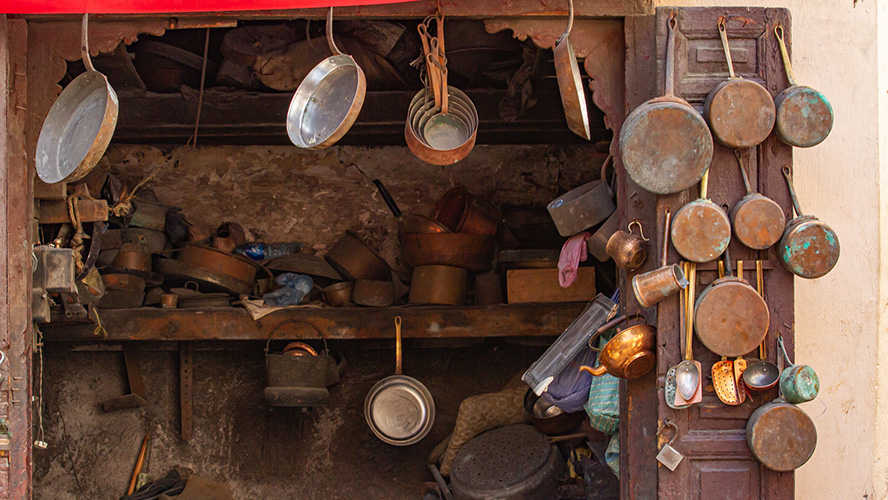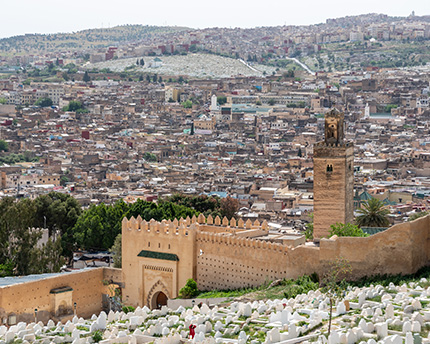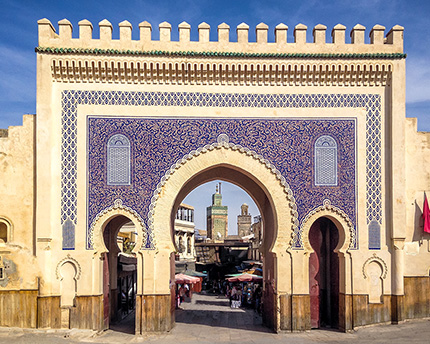As you walk through Fez’s labyrinthine medina, made up of thousands of streets and almost 300 neighbourhoods, you know when you are approaching Place Seffarine because you can hear what sounds like the beating heart of the city. That is thanks to the coppersmiths, the guild whose souk occupies this popular square, as they work the metal to create teapots, tea caddies, cooking implements and anything else you can imagine.
This craft, one of the oldest in the world, also determines the appearance of the souk, with gigantic cooking pots that are hired out for certain festivities.
But it also determines the colour of Place Seffarine, the ochre of the metal that, if we could fly up and view it from the sky, would contrast with the green of the roof of the world’s oldest university, which was founded in this square.
Place Seffarine: Its history and significance
This is one of the medina’s most traditional and important squares. It is the Coppersmiths’ square, thanks to the guild that occupies it, and the souk that was set up here. This square also witnessed the birth of the world’s first library, founded in the year 868 by a woman, Fatima Al-Fihri.
In fact, from an aerial view of Fes el Bali, two features stand out among the maze of ochre-coloured roofs and narrow streets: the river Ued Fez, the green of the library and the Al-Qarawiyyin mosque, which also stands in this square.

So we can say that Seffarine is a slice of the history of humanity that has remained almost intact with the passing of the years — and the same can be said of so many remarkable spots in Fez’s medina.
This square preserves not only one of the oldest crafts of this Moroccan city, but also the revolutionary spirit that inspired the library and the mosque which have both survived to modern times. Al-Qarawiyyin played a key role in the Moroccan nationalist movement against colonial French rule, as many of the movement’s members had studied at this historic mosque.
Activities and points of interest in the area around
Place Seffarine is worth visiting simply for the echoes of history that the coppersmiths have been bringing every day for centuries. In fact, many tourists gather here to enjoy the sight of the coppersmiths working, although nowadays the majority of them repair metal items, rather than manufacture them.
Nevertheless, Seffarine is also an essential visit for a tour of the Al-Qarawiyyin library, which challenged the society of its time, and not just because it was inspired by a woman.
The green-roofed complex includes the mosque, the library and the madrassa, considered to be the oldest university in the world. Its founder was Fátima Al-Fihri, the daughter of a rich immigrant from Kairuán, in Tunisia. This explains the name.
Within its walls, major poets and philosophers of the Arab world have studied, including Ibn Al-Arabi and Ibn Khaldun. The library holds volumes of the famous Al-Muwatta of Malik written on parchment, Sirat Ibn Ishaq, a copy of the Qu’ran given to the university by Sultan Ahmad Al-Mansur in 1602, and the original edition of the Kitab al-ʿIbar by Ibn Khaldun.
In the square you can also find the Seffarine Madrasa, one of the earliest buildings constructed by the Benimerines in the thirteenth century. Built as a riad, this Qu’ranic school is open to the public, but is not very well preserved.
During the sixteenth century, a hammam was built in the square, originally for the craftsmen who worked in the souk. Tradition has it that two Sufi saints, Sidi Tallouk and Sidi Ahmad Skalli, were buried in the baths, although they have never been found. The hammam has been restored and is open to the public: you pay at the entrance.
After your tour of the coppersmiths’ souk, you could stop at the café Abdullah and enjoy a good mint tea.
Crafts and traditional skills
Place Seffarine is where one of Fez’s oldest and most traditional crafts is practised: metal working (in this case, copper) using heat and a hammer to turn it into teapots, cooking pots, tea caddies, trays or containers used in the preparation of tagines or cous-cous, among other things.
Today, many of the craftsmen who work in this area use the same methods as their ancestors, although nowadays they often do repair work rather than actually making things.
It is fascinating to see them hammering the metal to a rhythm that is almost musical; each plays their part to perfection while several gigantic cauldrons have become part of the symbolism of the square. If you are wondering what they are used for, most of these Obelix-sized pots are hired out for ceremonies.






































































